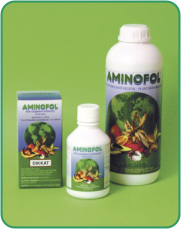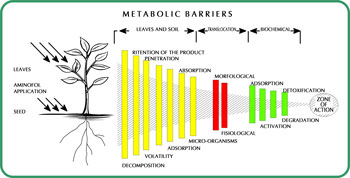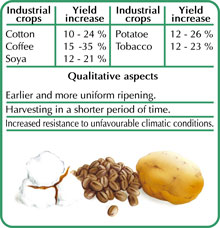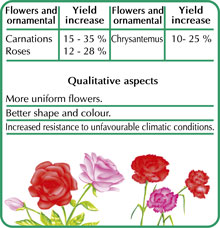For all nursery crops we suggest a treatment
a few days before transplanting at a dosage of 100-200 ml/hl.
A
treatment is also recommended if weather conditions show danger
of water and/or thermic stress (drought, low or sharp changes
in temperature), at a dosage of 30 ml/hl.
When possible we suggest to apply AMINOFOL® by mixing it with the
other pesticides usually used.
When the dosage rates are referred to hectares (ha) they are inclusive
of all treatments; instead if they are referred to hectolitres
(100 l.) they are relative to a single treatment considering a
water spray volume of 1000 litres/ha.
AMINOFOL®’s dosage rates
for application on crops
|
Crops
|
No. treatments
|
Dosage
|
Period
of application
|
Vegetables |
| GARLIC |
3 |
400/500
ml/ha - 20 ml/hl |
1st: When plants are 5-10 cm. high.
2nd
and 3rd: at one month intervals.
|
| ONIONS |
3 |
400/500
ml/ha - 20 ml/hl |
1st: When plants are 5-10 cm. high.
2nd: one month later. 3rd: one month before picking. |
BROCCOLI -
CABBAGE -
CAULIFLOWER |
3 |
400/500
ml/ha - 20 ml/hl |
1st: Before transplanting.
2nd: 10-15
days later.
3rd: one month later. |
CUCUMBERS-
ZUCCHINI |
3 |
600/800
ml/ha - 20/30 ml/hl |
Starting when plants have 6/8 leaves,
repeat every 10-15 days. |
WATERMELONS
MELONS |
3 |
600/800
ml/ha - 20/30 ml/hl |
1st: Before flowering.
Repeat every
10-15 days. |
| CARROTS |
2 |
400/500
ml/ha – 20/30 ml/hl |
1st: When plants have 3/4 leaves.
2nd:
one month later. |
STRING BEANS -
BEANS |
3 |
|
1st: When plants have 6/7 leaves.
2nd:
before flowering.
3rd: during first bud growth. |
AUBERGINES -
PEPPERS
TOMATOES |
4 |
600/800
ml/ha - 20 ml/hl |
1st: Before transplanting.
2nd: 7-10
days later.
3rd: when buds appear.
4th: during fruit growth. |
| PEAS |
2 |
600 ml/ha – 20 ml/hl |
1st: Before flowering.
2nd: at early
setting. |
| POTATOES |
3 |
600 ml/ha – 20 ml/hl |
1st: When plants have 5/6 leaves.
Repeat
every 20-30 days. |
| STRAWBERRIES |
4 |
600/800 ml/ha – 20 ml/hl |
1st: After transplanting.
2nd: during
plant growth before flowering.
3rd: during setting.
4th:
during summer rest. |
Fruit trees |
| PINEAPPLE |
2 |
400/600 ml/ha – 20/30 ml/hl |
1st: At the end of “true flowering”.
2nd:
30 days later. |
| AVOCADO |
3 |
600 ml/ha |
1st: Before flowering.
2nd: 35-40 days
later.
3rd: one month later. |
| BANANA |
2 |
1800 ml/ha |
1st: When plants are half way through
flowering.
2nd: 20 days later. |
| CITRUS FRUIT |
3 |
100/1200 ml/ha – 40/50 ml/hl |
1st: Before flowering.
2nd: when fruits
have a diam. of 2-3 cm.
3rd: 3 weeks later. |
| KIWI ACTINIDIA |
4-6 |
1000/1200 ml/ha – 20/30 ml/hl |
Every 3 weeks starting from vegetative
growth. |
| APPLE - PEAR |
4 |
800/1200 ml/ha – 20/30 ml/hl |
1st: When buds appear.
2nd: during
setting.
3rd and 4th: at 2-3 week intervals. |
PEACH –
DRUPACEOUS |
3 |
800 ml/ha – 30 ml/hl |
1st: Before flowering.
2nd: at the
beginning of setting.
3rd: 15-20 days later. |
| PAPAYA |
3 |
600/800 ml /ha – 20/30 ml/hl |
1st: Before flowering.
2nd: when fruits
are 5 cm. long.
3rd: 4 weeks later. |
| OLIVE |
2 |
600/800 ml/ha – 30/40 ml/hl |
1st: Before flowering.
2nd: at the
end of setting when fruits have a diam. of 1-2 cm. |
| GRAPE |
3 |
800/1000 ml/ha – 30 ml/hl |
1st: At early flowering.
2nd: at the
end of fruit setting.
3rd: when grapes are closing. |
CEREALS |
WHEAT –
BARLEY –
OATS |
1 |
600/800 ml/ha |
Between the end of tilling and the
beginning of the rising stage when herbicides are applied.
We
also suggest to dress the seeds necessary to sow 1 ha with
100-200 ml of AMINOFOL®. |
CORN – SORGHUM –
SWEET CORN
|
1 |
600/800 ml/ha |
When plants have 4/6 leaves. |
| RICE |
1 |
800 ml/ha |
Between the end of tilling and the
beginning of the rising stage when herbicides are applied.
We also suggest to dress the seeds. (See WHEAT above). |
INDUSTRIAL CROPS |
| COFFEE |
2 |
900 ml/ha |
1st: Before flowering.
2nd: 3 weeks
later. |
| COTTON |
2 |
400/900 ml/ha |
1st: Before flowering.
2nd: one month
later. |
| SOYA BEANS |
1 |
800 ml/ha |
When plants have 6/7 leaves. |
| SUGAR BEET |
1 |
600/800 ml/ha |
When plants have 6/7 leaves. |
| TEA |
4 |
800/1000 ml/ha - 20/30 ml/hl |
Every 7 days starting from pruning. |
| TOBACCO |
3 |
800 ml/ha - 30 ml/hl |
1st: Before transplanting.
2nd and
3rd: at week intervals. |
FLOWERS –
ORNAMENTAL
PLANTS |
|
100/200 ml/hl – 5/10 ml/lt |
Every 7-10 days starting from vegetative
growth. For home gardens. |









